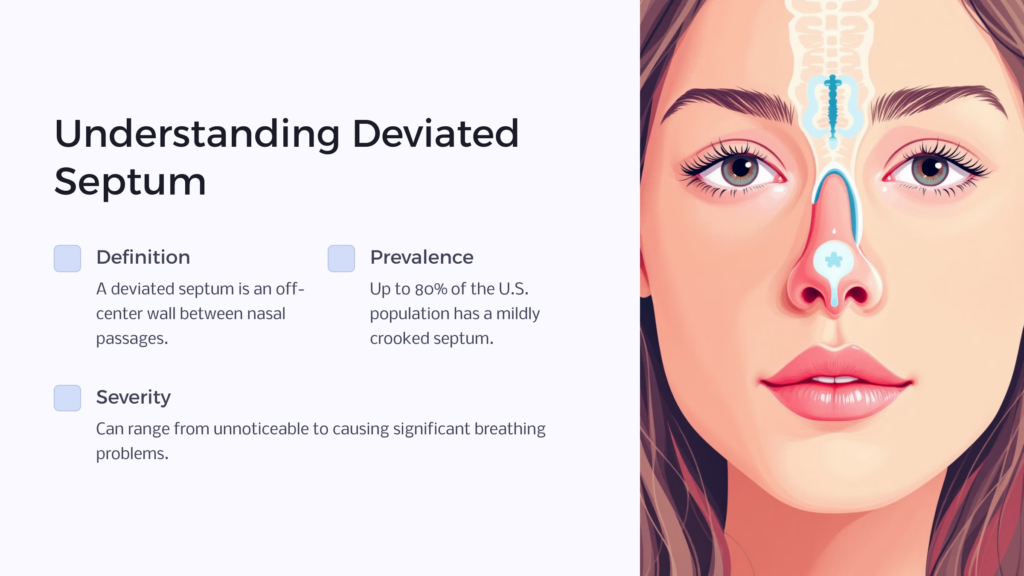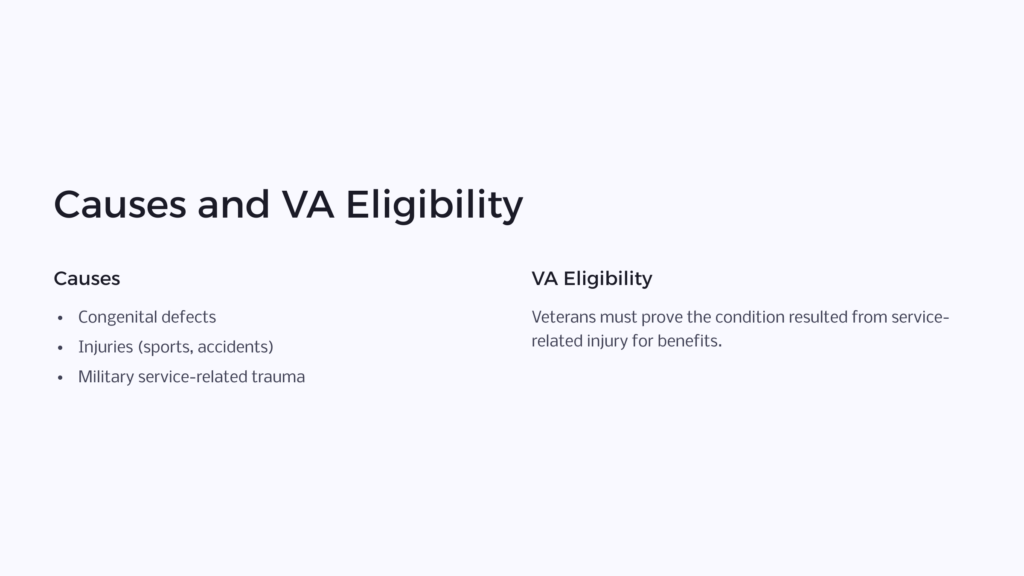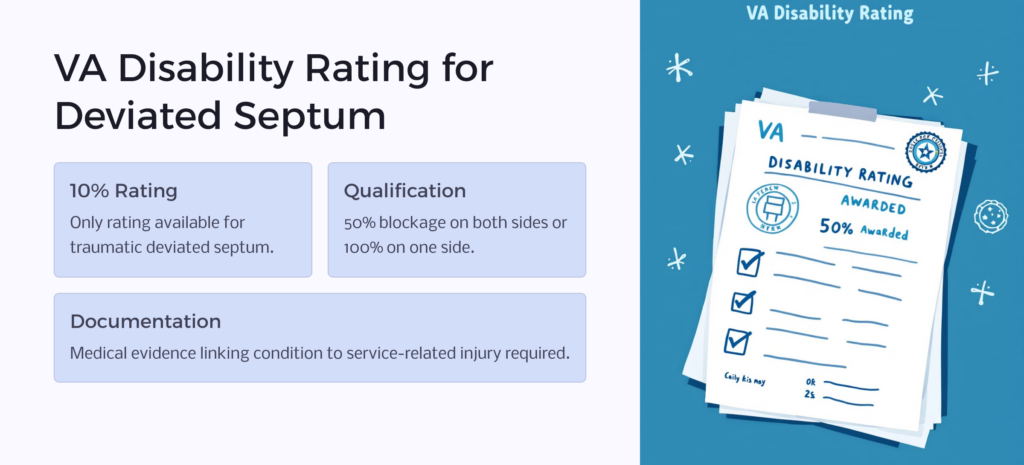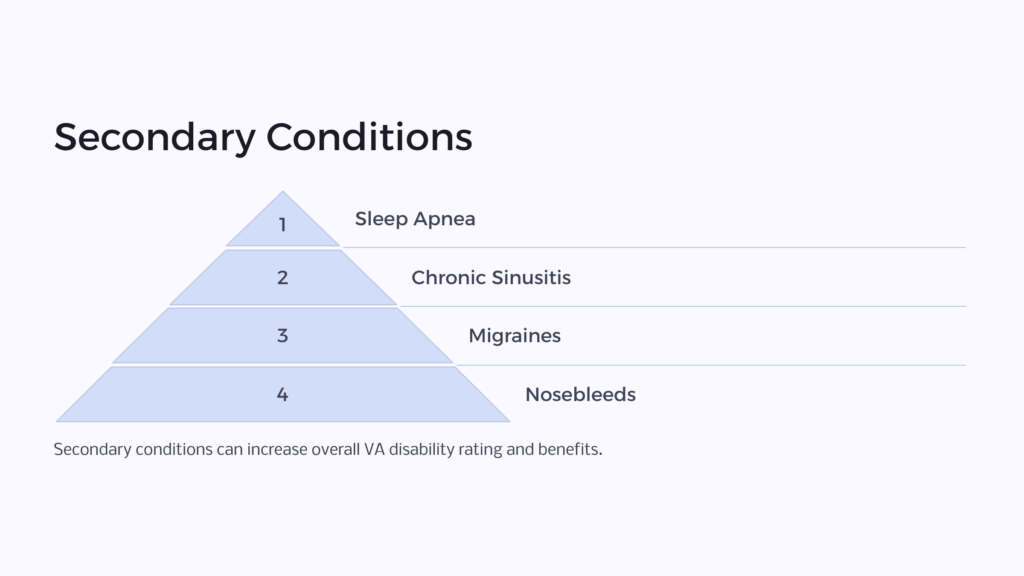The VA rates a deviated septum under Diagnostic Code 6502, with the only possible deviated septum VA rating being 10%. The VA may also assign additional disability ratings for secondary conditions related to a deviated septum, which can increase your overall compensation.
What is a Deviated Septum?

The nasal septum is the thin wall of cartilage and bone that separates the right and left nostrils. Ideally, the septum is straight and divides the nasal cavity equally.
A deviated septum occurs when the septum is displaced or crooked, resulting in one nasal passage being significantly narrower than the other, which can significantly impact airflow and breathing.
A facial injury or broken nose, as can happen during military service, can cause a deviated septum. Diagnosis typically involves a physical examination by a medical professional to assess the nasal structure and symptoms.

Establishing Service Connection
For the VA to consider your deviated septum as service-connected, you must prove service connection by providing evidence that links your deviated septum to specific incidents during your military service.
If your deviated septum was pre-existing or congenital, you may still qualify for VA disability benefits if you can show that military service aggravated the condition.
Relevant medical records and documents for filing a VA disability claim includes your DD214, service treatment records, and private medical records, including a medical nexus letter.
How the VA Rates a Deviated Septum (Diagnostic Code 6502)
The VA uses Diagnostic Code 6502 to determine the VA rating for a deviated septum. This code, part of the VA Schedule for Rating Disabilities (VASRD), is used to assign a specific rating based on the severity of the condition.
The VA rates a deviated septum at 10% if there is 50% or more obstruction of both nasal passages, or complete obstruction of one, and at 0% if there is no significant obstruction of breathing.

Common Symptoms That Affect Your Rating
Symptoms that commonly appear in deviated septum VA claims can provide evidence for broader health issues. These include:
- Frequent nosebleeds
- Chronic nasal congestion
- Recurring sinus infections
- Trouble breathing through the nose
- Difficulty breathing
- Facial pain or pressure
- Headaches and post-nasal drip
Veterans are encouraged to keep a symptom diary to document the frequency, severity, and impact of their symptoms, as this can provide comprehensive evidence for medical evaluations and disability compensation claims.
A deviated septum can also lead to chronic headaches or migraines as secondary conditions. In some cases, veterans also report sleep apnea or snoring, and difficulty using a CPAP machine, especially when the deviated septum restricts airflow.
These additional issues might not raise your deviated septum rating itself, but they can play a role in connecting secondary conditions.
Secondary Conditions Linked to a Deviated Septum
If your deviated septum leads to or aggravates another medical issue, you can claim both together as primary and secondary conditions.
Common secondary conditions include:
- Chronic sinusitis (rated under Diagnostic Code 6512, up to 50%)
- Sleep apnea (can be rated 0%, 30%, 50%, or 100% depending on severity and CPAP use)
- Rhinitis (chronic or allergic, sometimes rated at 10% or 30%)
- Migraines due to sinus pressure or chronic headaches as a result of a deviated septum
- Anxiety or depression related to sleep disruption or chronic pain

How To File or Increase a Deviated Septum VA Claim
If you’ve never filed for a VA disability claim for nasal obstruction, here’s how to start.
- Gather medical records that document your condition, including CT scans or ENT evaluations, and make sure to include your full treatment history to show all past medical interventions and therapies related to your deviated septum.
- File a claim through VA.gov or with help from a Veterans Service Officer (VSO).
- Include a nexus letter if your septum injury is not clearly documented in your service records.
- Attend your C&P exam (Compensation & Pension exam) and clearly explain how your condition affects your daily life.
To request an increased rating for your deviated septum, submit a VA Form 21-526EZ along with new medical evidence showing worsened symptoms or qualifying secondary conditions. This can help you receive a higher VA disability rating and increase your overall benefits.
Other Respiratory and Sinus Ratings That May Apply
Even if your deviated septum alone doesn’t qualify for a high rating, related conditions—such as other respiratory and sinus issues—can carry weight and get you more VA benefits. Look into whether any of the following may apply:
- Chronic sinusitis (Diagnostic Code 6512)
- Allergic rhinitis (Diagnostic Code 6522)
- Obstructive sleep apnea (Diagnostic Code 6847)
- Asthma or bronchitis, if your nasal obstruction contributes to lung function issues
By linking these related conditions to your deviated septum, you may increase your eligibility for VA benefits, as the VA considers the combined impact of these issues when evaluating your disability compensation.
Your overall disability rating might increase significantly when these conditions are appropriately linked to your primary diagnosis.
Final Thoughts on Getting the Right Rating
While the VA disability rating for a deviated septum may appear modest, it’s important to recognize that your condition can have broader impacts on your health and daily life. Breathing difficulties that disrupt sleep, trigger chronic sinus infections, or limit everyday activities deserve full consideration, not dismissal.
 Benefits.com Advisors
Benefits.com Advisors
With expertise spanning local, state, and federal benefit programs, our team is dedicated to guiding individuals towards the perfect program tailored to their unique circumstances.
Rise to the top with Peak Benefits!
Join our Peak Benefits Newsletter for the latest news, resources, and offers on all things government benefits.


















